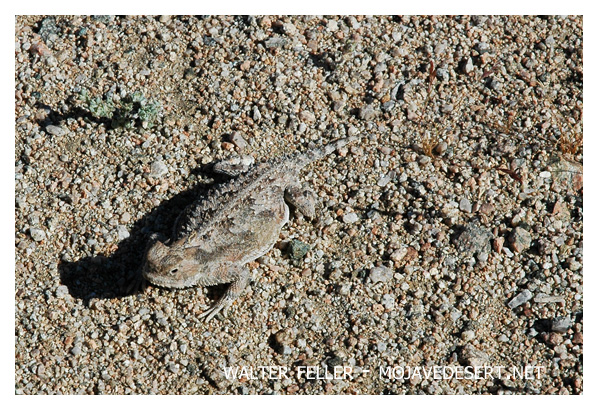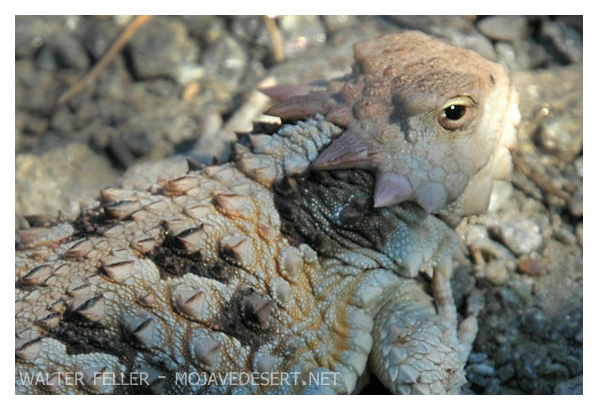Denizens
The Desert Horned Lizard
(Phrynosoma platyrhinos)ALL those who have walked abroad on the desert at all observantly must have met that little lizard of the sands which has achieved its fame under the name of the horned toad. Because of its wide departure from the unprepossessing snakelike form of many of its reptilian congeners, and because of its unique and interesting habits, it has doubtless earned the good will of man more than any of our lizards. I have yet to find among the roughest miners and frontiersmen one who would purposely harm one; they always speak of them fondly.

Near Coyote Holes the writer found a veteran prospector named Johnson who had four horned lizards about his shanty and he seemed to think almost as much of them as he did his faithful burros. It was almost pathetic and at the same time pleasing to note what care he bestowed upon them. He fed them almost daily a meal of flies and talked to them as to children. There was seemingly even in the hearts of those dumb creatures some feeling of gratitude and fellowship. They apparently knew their friend, and, when they heard him walking about with his heavy hobnailed boots on the rough board floor, they would shuffle out on the step and bask there in the sunshine until their beneficent keeper threw down some meal worms or flies and talked to them. They would lick up the flies and worms with their viscid tongues and feed until full when they would waddle away to "sleep it off."
The "horned toad" is totally different in appearance from any of our other lizards. The body is unusually flattened, and he carries on his head those enormous horns which are "without precedent among his modern kith and kin."
"Any one who has seen a horned lizard on the defensive," writes Dr. Harold Bryant, "cannot doubt the value of these horns as a protection to the animal. With its head lowered so as to receive any blow on the horns and the large scales of the back elevated, it presents a very formidable appearance."
So perfectly does the horned lizard's light color blend with the gravel and sand that it is almost impossible to see him when he is quiet. Time after time when walking on the dunes I have almost stepped upon horned lizards, and would have crushed them under foot had they not shambled off and through their motion apprised me of their presence.
A detailed examination of the body brings to light several other peculiar adaptations to a life on the sands.

In many individuals the ear drum is almost wholly concealed by a scaly membrane, a peculiarity found only among desert species. The ear is often further protected by folds in the scaly skin of the short neck. Just beneath the outer horny skin covering are numerous pigment cells, each with its yellow pigment granule or chromatophore. These highly developed color bodies are under the direct control of the nervous system and the animal is able to make color adjustments with a fair rapidity, so that if its wanderings carry it onto darker or lighter soils it is capable of bringing about a color coat suitable to its environment.
Mr. Leonhard Stejneger, who made the report on the reptiles collected on the Death Valley Expedition (1893), found that the horned toads which lived on the intensely white alkali soil around Ash Meadows in the Amargosa Desert were much [lighter in color than usual. Other specimens taken elsewhere showed great variation in color ranging "from a very pale, in some nearly whitish drab-gray, to a vivid brick red."
The bony, rigidly built head is short and triangular in shape adapting it admirably as a tool for burrowing into the sand. When a horned lizard desires to cover himself for the night, he forces his wedge-shaped head into the sand just like a chisel, driving it forward by means of the legs. To facilitate the movement the whole body is wriggled back and forth. The last act in the burying procedure is a flip of the tail which covers the last visible appendage. It is surprising in what a short time the animal is completely hidden.
Horned lizards exhibit a marked preference for the sandy washes and are never known to occur on the rocky hillside. The reason for this is obvious, it being absolutely necessary for them to have loose sand in which to make their shelter for the nights and cool days. They are active only during the heat of the day, generally confining their activities to the midday hours, but even with them there is a limit to the amount of heat they can stand. During the hottest part of the summer season they seek the shade or go under the sand during the hours of highest temperature and do their feeding during the late afternoon. The least cool weather sends them underground. Their hibernating season begins early in November and continues until about the first of March.
Dr. Bryant, who has made a special study of these reptiles, has accumulated abundant evidence to show that these scaly animals are exemplary destroyers of insects. Left to their own devices they destroy an amazing number of ants, noxious beetles, and flies. "Unless very hungry," writes Dr. Bryant, "live insects alone satisfy a Phrynosoma. In fact, their eyes seem unable to distinguish an insect unless it moves, so that this may largely govern the feeding habit. On seeing its prey, a Phrynosoma has a habit of raising and lowering itself on its front legs much as a lizard does when sunning itself on a rock. Always when feeding it raises itself well on its legs seemingly to avoid being bitten. The moment the insect moves, the horned lizard darts for it, catches it on the end of its viscid tongue, swallows it alive, and backs off again. Why this animal is never bothered by being stung internally by the ants it eats seems hard to explain. Certainly the mouth and stomach must be particularly adapted to withstand the poisonous sting of insects, for when stung externally the lizard shows no little discomfiture.
Sand, dirt, and even small pebbles are often found in the stomach. These are probably taken in the act of swallowing the prey. I have found nematodes (parasitic round-worms) in several stomachs I have personally examined.
It is believed that the road-runner and the rattlesnake are his two worst enemies. Against such an enemy as the road-runner, whose keen eye is ever on the alert to discover fresh sources of food to appease his enormous appetite, the slow-moving horned lizard is practically defenseless. If he is close to a hole or bush, or if he taxes his wits to the limit, he may try to escape by burying himself in the soil, but his chances for escape are exceedingly slim.
The tradition found among the Indians to the effect that a horned lizard is able to burrow its way out of a rattlesnake's stomach seems to have some foundation in fact. "Rattlesnakes have been found," writes Dr. Bryant, "with the head of a horned lizard protruding through the body wall. Rattlesnakes have also been found with the horns of a Phrynosoma caught in the throat."
Several young are borne at a time, each a minute edition of its parents. They all have their trial at life, but because of the many enemies a great number never reach the adult state. As soon as the spring well opens up, they are very much in evidence in almost every wash or dune area. When first borne .they are so tiny that it would seem that they were utterly incapable of taking care of themselves, but the great number of adults to be seen at any time is evidence enough that they are very well able to provide themselves with both food and shelter.
Horned toads in moulting shed, not the entire skin at once as snakes do, but scale off gradually. Since the skin consists of continuous layers, it loosens in patches of various sizes and either drops of its own accord or is rubbed off by the animal's ordinary movements. The cartilaginous caps covering the horns are shed in one piece.
The desert horned lizard inhabits all the hot arid low-plain environments of the Great Basin and Salton Sink, occurring as far east as western Utah. In the extreme southwestern limits of its range it is associated with the flat-tailed horned lizard (Anota macalli Hallowell). The horned toad of the Pacific Slope is a distinct species.
Horned Lizard
Feeds primarily on ants, also beetles and their larvae, and plant material.